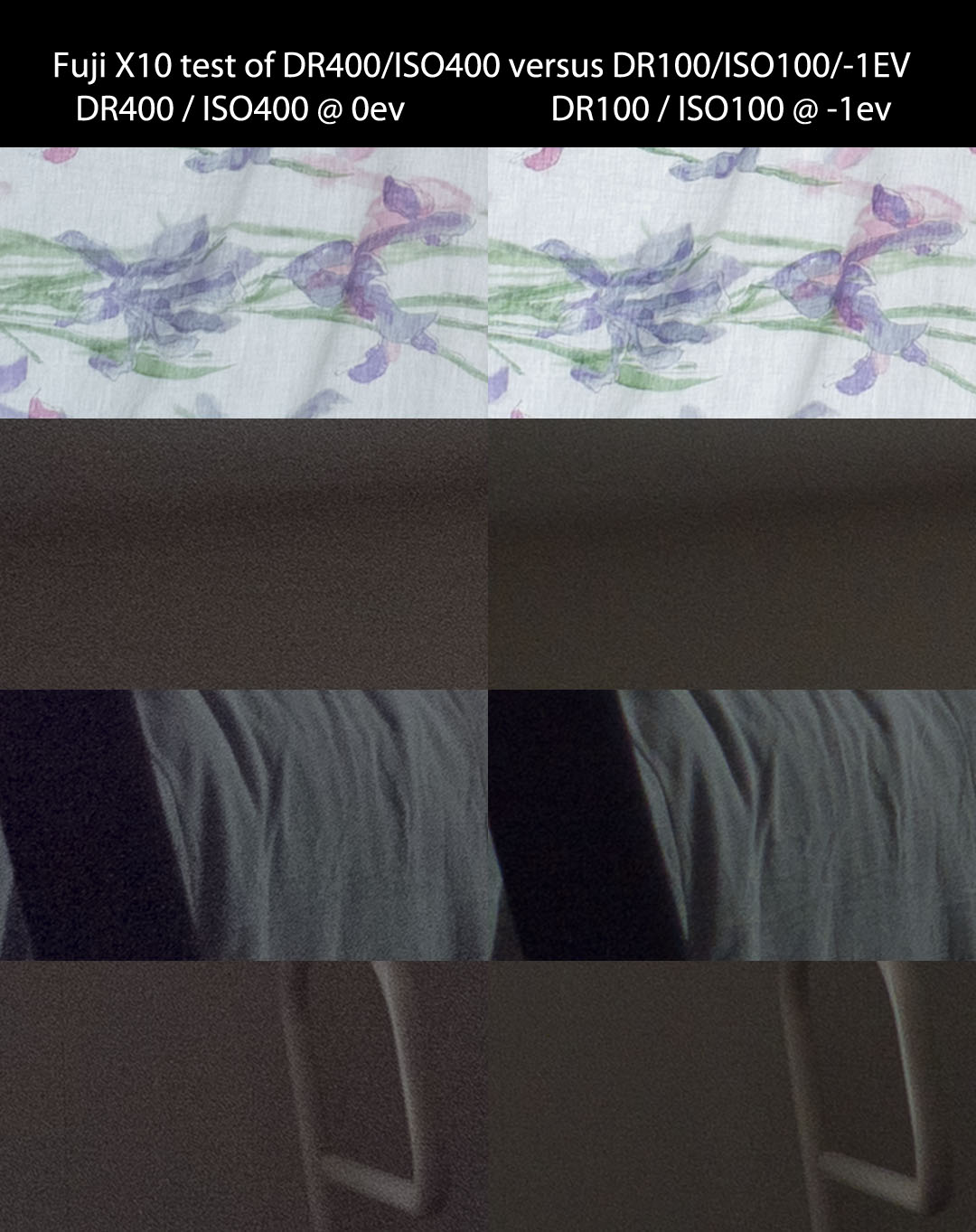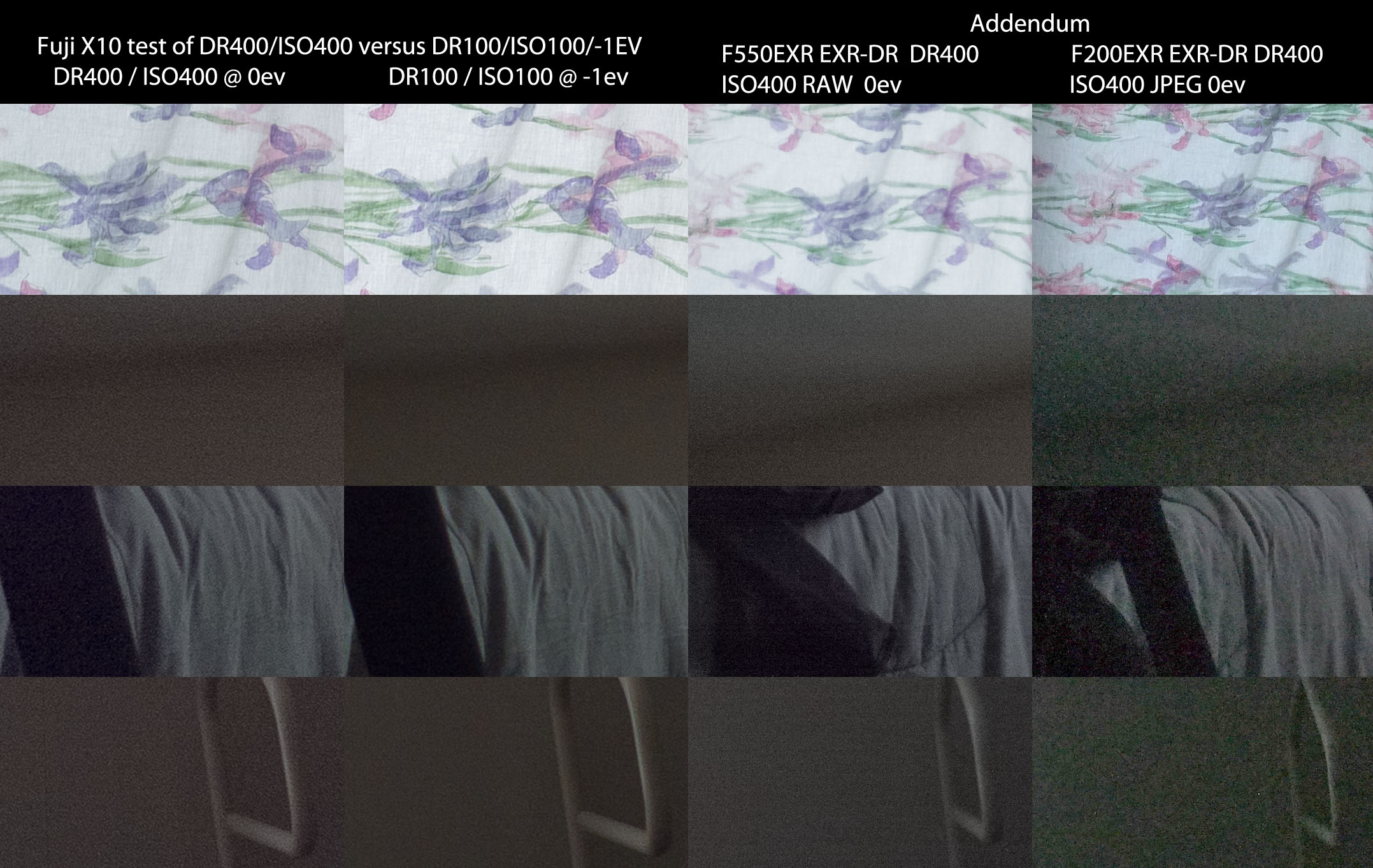Fuji manipulates the heck out of their RAW files. The inconsistencies we see in all sorts of metering ways on the X10 are probably there because Fuji are not just capturing the usual data any more. They are capturing hidden data (metadata I presume) about the exposure and perhaps even performing some split sensor antics. It is really hard to tell.
So … my X10 examples. I shot an ugly area of my house (under construction, but has the virtue of a translucent window covering that is much brighter than the walls beside it.) These images shall remain unseen, but crops from them are gathered together along with all the metadata from Bridge, ACR, CS5 and the Camera. So let’s compare notes …
Obviously, you simply must click that image to see the huge one … and remember to expand further if your browser shrinks it to fit the window (most do when loading.) It will open in a separate window so you won’t lose your place.
Now … from left to right:
- Shadow area. 400 ISO causes color shift and large increase in noise.
- Highlight area. By default ACR sees both exposures as blown out.
- CS5 histograms shows identical data in file. Bridge says both are 4000x3000 (12mp.) But CS5 sees a larger file for 400 ISO / DR400! WTF?
- Camera shows much different histograms, yet identical exposures overall. WTF? Note: Both show some flashing overexposure, but it is extreme with DR100.
- After pulling exposure slider all the way left in ACR for both images, CS5 shows completely different results. DR100 file still blown. DR400 file actually underexposed now by 1 full stop.
I went back and played with the compensation dial and was surprised that –2EV created a perfect exposure at DR100 … no blown highlights flashing at all. This leads me to consider that DR400 offers something like 1.66 stops of protection. However, the shadow color shift and the excess noise is the price for preferring to shoot without dialing in compensation yourself.
I doubt that we’ll ever get told the secrets of Fuji’s RAW files for EXR. But it certainly helps to understand why Fuji think they might be able to fix the ORBs in firmware. The sensor is probably in good shape, but their processing of the RAW file is quite aggressive …
Update
I could not contain my curiosity … would 400ISO at 0ev pulled down in ACR be better than 100ISO at –1ev pulled up in ACR?
The obvious answer is that they should be close. Underexposure is never your friend … but 2 stops of ISO is a lot on such a small sensor. And for those of you who think this is a large sensor, well, I think you’ll see in a moment that this is just not true.
Again, click through to see a clear view of the damage that raising ISO has done. Here is my summary:
- Color shift toward blue. Classic small sensor issue. But starts early on the X10 for its sensor size.
- Tons of extra noise. Much more than on the underexposed 100 ISO image.
- Details destroyed. Crop 3 shows small fabric folds lost and crop 4 shows edge details lost.
- I see a vertical line of darker pixels across the left side of crop 4. More pronounced at 400 ISO but still slightly visible at 100 ISO.
My bottom line: I would not shoot DR400 on this camera when there is dark shadow detail that matters. I would choose instead to properly expose for the subject and the highlights in the frame, then pull up in post. All done in RAW of course.
Those who might want to believe the endless commentary about how great 400 ISO is and how cool it is that you can over expose with no ramifications would be far better served by:
- learning how to meter a scene (try some of these)
- exposing to the right
- using the lowest possible ISO for the available light, which means 100 for most daytime shooting
- shooting RAW and processing in ACR
Compared to the F550EXR and the F200EXR
The former has RAW but a really tiny sensor at 1/2” … the latter has a large sensor (a fraction smaller than that of the X10) but has no RAW and uses older CCDEXR technology. So what does that all mean?
Again … CLICK THROUGH.
The F550 is really quite good. It fails to resolve the detail on the first crop but has finer grain than the X10 on the second. Same color shift at the same ISO. Third crop is again about the same as well. The fourth crop shows two differences: the smaller sensor cannot quite hold the edges and there is some minor banding. If you see a lot of banding, consider monitor calibration. I see a lot on my TN panel, but my IPS panel shows minimal. So all in all, a surprising performance for a sensor that is a full stop smaller.
Now, how about that big sensor in the F200? Well, looks like bad news. No RAW and its conservative meter (it set an exposure about 3.25 stops less than the F550’s meter) has really tanked it. You have to be very careful with the F200 if you want to hold highlights and see some shadow detail. The first crop is nice and the rest are a mess. The last is a legitimate disaster. The F200 protects highlights better than the others, but it appears that its trick is mainly hyper conservative metering.
Addendum for JPEG Shooters
This article is all about RAW and the tricks Fuji uses when shooting in pure RAW. You get some protection, but I consider the price overly high.
I just shot a JPEG file in EXR DR / DR400 mode on the X10 and the image was only slightly overexposed. I could still pull back the blown out sections and open the shadows and I observe that the image is much nicer than the RAW DR400 image. EXR DR chose 125 ISO and did not shift colors, nor did grain overwhelm the detail. Of course, it is a jpeg file and therefore there is subtle smoothing in a lot of places and of course there is some compression. Still, it is a better alternative than RAW DR400 on the X10.
Conclusion(S)
Fuji is manipulating RAW files very significantly with the X10. Nothing quite adds up, and ORBs are coming from somewhere. But there are some obvious conclusions from this test:
- You can shoot DR400 and pull back a lot of overexposure (almost 2 stops) in RAW. But you pay a big price in shadow noise and color shifting.
- You can dial in compensation yourself and raise shadows and mid tones. This looks much better in practice.
- JPEG EXR-DR DR400 ISO100 does a better job than RAW DR400 ISO400 when there is dark shadow detail that matters (and therefore must be lifted.) RAW ISO100 DR100 –1EV does an even better job.
- The F200EXR is out of its league when the light falls badly in the shadows. This was a surprise to me.
- The F550EXR has the same sensor technology without some of the weird quirks. For a much smaller sensor, it remains quite competitive.


